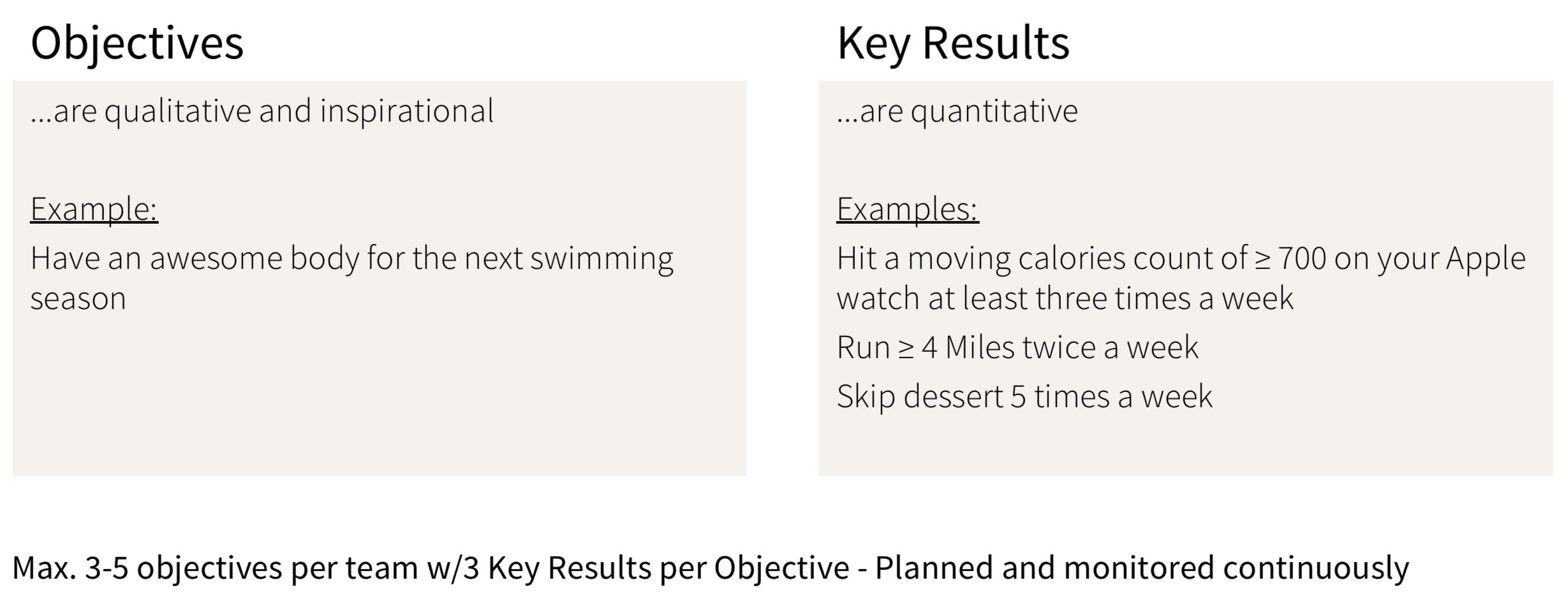
Objectives & Key Results (OKRs)
Objectives and key results (OKRs) are a method for aligning an organization on a set of core aspirational goals and having it execute in a concerted fashion against them. Popularised by Google it is now widely used in the technology industry.
Purpose
To focus the execution of an organization towards a common set of goals.
Outcome / Deliverables
A joint understanding of an organization’s goals that is supported by a set of linked objectives and commitments.
Detailed description
OKRs have originally been “invented” at Intel and become very popular among tech companies by virtue of Google publicly adopting and promoting them.
OKRs stands for Objectives and Key Results. They are being used to align the organization and its individuals with a limited set of aspirational or stretch goals. OKRs are usually agreed for a set period of time e.g. a business quarter and follow a more or less standardised format.
The Objective itself is typically stated as a single sentence, that outlines the aspired goal. Key Results are being framed as numerically measurable statements (see example).
Most companies use a format where company, organization, and employees each develop a maximum of 5 objectives, each typically supported by 3–4 key results.
The power of OKRs arises mainly from two factors:
1. Objectives are supposed to contribute to the highest level company objectives such that on the way “up” employee objectives pay in on a team’s objectives which in turn support a department’s objectives, which then are key items in the overall company’s objectives.
2. In addition, all OKRs are public across the company, that way creating a transparency that lets everyone understand what the other’s priorities are and how they contribute to the overarching company objectives.
Personal OKRs are developed by the employees themselves, trying to cater to the organization’s larger goals in their particular domain. As a rule of thumb at least 60% of individual OKRs should be “bottom up” (with >50% supporting larger overall goals), thus harnessing the employees’ ideas with respect to the company’s larger objectives.
At least 50% of team or departmental OKRs should be developed „bottom up“ to take into account a team’s subject matter expertise in support of overarching objectives.
Good OKRs are as independently actionable as possible trying to avoid dependencies wherever possible.
OKRs are to be voluntarily, yet ambitiously set, such that they are barely reachable within the period in question. Achievement levels of .6 to .7 are considered to be satisfactory – below .4 raises questions about the ambition set out. Outcomes are publicly discussed on all levels and learnings extracted wherever possible.
As a rule, OKRs are totally decoupled from the annual employee performance appraisal process, underlining their voluntary nature and supporting their aspirational character.
OKR-processes are structured as lightweight as possible with emphasis on regular review, discussion, and learning – not on double digit outcome precision
Dos & Dont’s
- Do ensure reflection of company OKRs in team or individual OKRs
- Do discuss OKRs openly and regularly
- Do hold OKR result meetings early in the agreed period (quarter)
- Do ensure that OKRs are indeed a stretch
- Don’t use OKRs in performance appraisals
- Don’t put too much emphasis on the accuracy of the grading process
Further Reading
- Great basic lecture on OKRs: Google Venture partner Rick Klau’s presentation https://rework.withgoogle.com/guides/set-goals-with-okrs/steps/watch-googles-OKR- presentation/
- Silicon Valley author Christina Wodtke’s Elegant Hack blog entry http://eleganthack.com/the-art-of-the-okr/

